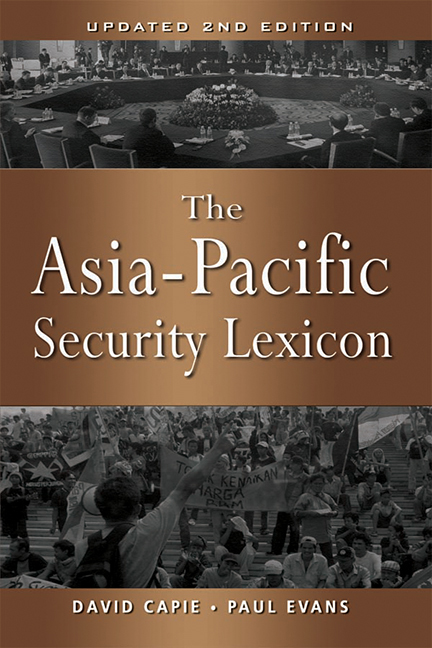Book contents
- Frontmatter
- Contents
- Abbreviations
- Introduction to the Second Edition
- Ad Hoc Multilateralism
- A la Carte Multilateralism
- The “ASEAN Way”
- Balance of Power
- Bilateralism
- Coalition of the Willing
- Coercive Diplomacy
- Collective Defence
- Collective Security
- Common Security
- Comprehensive Security
- Concert of Powers
- Concerted Unilateralism
- Confidence-Building Measures
- Confidence- and Security-Building Measures
- Constructive Intervention
- Cooperative Security
- Engagement
- Flexible Consensus
- Human Security
- Humanitarian Intervention
- Middle Power
- Multilateralism
- Mutual Security
- New Security Approach
- Non-Traditional Security
- Open Regionalism
- Peaceful Rise
- Pre-emption and Preventive War
- Preventive Diplomacy
- Security Community
- Terrorism
- Track One
- Track One-and-a-Half
- Track Two
- Track Three
- Transparency
- Trust-Building Measures
- About the Authors
Coercive Diplomacy
Published online by Cambridge University Press: 21 October 2015
- Frontmatter
- Contents
- Abbreviations
- Introduction to the Second Edition
- Ad Hoc Multilateralism
- A la Carte Multilateralism
- The “ASEAN Way”
- Balance of Power
- Bilateralism
- Coalition of the Willing
- Coercive Diplomacy
- Collective Defence
- Collective Security
- Common Security
- Comprehensive Security
- Concert of Powers
- Concerted Unilateralism
- Confidence-Building Measures
- Confidence- and Security-Building Measures
- Constructive Intervention
- Cooperative Security
- Engagement
- Flexible Consensus
- Human Security
- Humanitarian Intervention
- Middle Power
- Multilateralism
- Mutual Security
- New Security Approach
- Non-Traditional Security
- Open Regionalism
- Peaceful Rise
- Pre-emption and Preventive War
- Preventive Diplomacy
- Security Community
- Terrorism
- Track One
- Track One-and-a-Half
- Track Two
- Track Three
- Transparency
- Trust-Building Measures
- About the Authors
Summary
Describes the use of limited force or the threat of force to achieve a specified diplomatic outcome. According to Sumit Ganguly and Michael Kraig, “the essential distinguishing feature of [coercive diplomacy] (and possibly its only consistent feature) is that it involves the threat of the use of force or the limited use of force. In essence, the coercing state uses this method to induce an adversary to desist from ongoing hostile actions and reverse any gains it has made.”
According to Alexander George, there are three possible goals for coercive diplomacy: to get an adversary to stop an action already underway short of its goal; to persuade the adversary to reverse an action already carried out, and to attain “cessation of the opponent's hostile behaviour through a change in the composition of the adversary's government or in the nature of the regime”. Coercive diplomacy differs from deterrence, in that deterrence uses the threat of force only to dissuade an opponent from doing something that has not yet begun. It is also different from traditional military strategies. The target state's military “stays largely intact, and its overall ability to fight is not severely degraded”. Or in George's rather more colourful expression, the goal is to “persuade an opponent to cease his aggression, rather than bludgeon him into stopping”. Any use of force is designed to be exemplary, “to create a dramatically heightened sense of risk — an urgent fear by the elites of the targeted state that if they do not reverse course, disaster will surely ensue”. According to Barry Blechman and Stephan Kaplan, “with coercive diplomacy, military units themselves do not attain the objective; goals are achieved through the effect of the force on the perceptions of the [targeted] actor”.
For its proponents, coercive diplomacy has advantages over diplomacy or the resort to war. “It is more compelling than diplomacy alone, for it carries with it the explicit threat of resorting to war if compliance is not forthcoming within a specified time span.
- Type
- Chapter
- Information
- The Asia-Pacific Security Lexicon (Upated 2nd Edition) , pp. 43 - 46Publisher: ISEAS–Yusof Ishak InstitutePrint publication year: 2007

